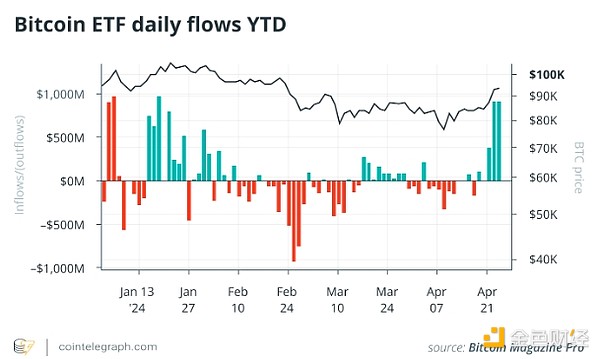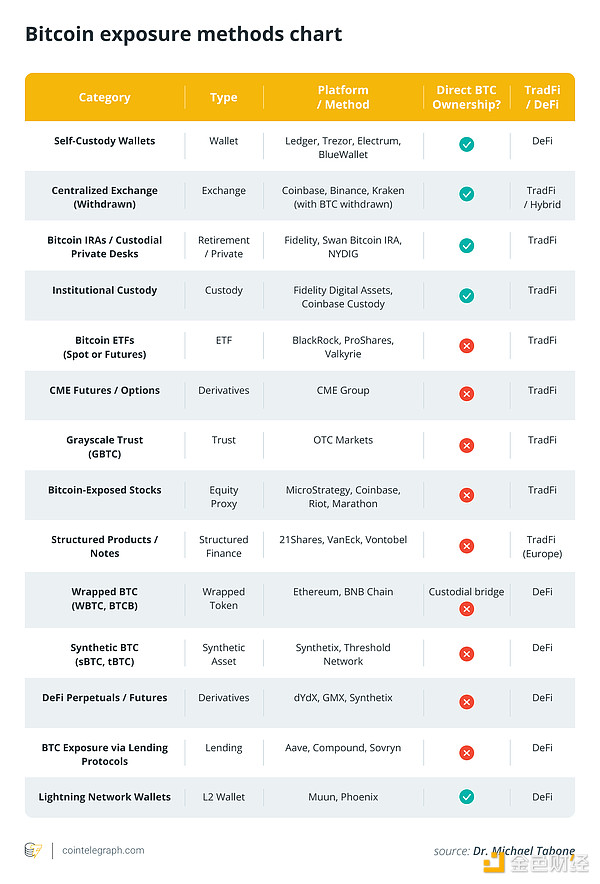Author: Michael Tabone, CoinTelegraph; Compiler: Baishui, Golden Finance
The capital tide that once flowed to the original spot Bitcoin has begun to flow through institutional channels, spot exchange-traded funds (ETFs), structured products and wrapped exposures, and although the enthusiasm has risen rapidly, the waves are not exactly the same.
Eric Balchunas, senior ETF analyst at Bloomberg, pointed out on X that leveraged long ETFs have a large trend, while safer bets such as gold and cash are also relatively active. Suppose people have to choose whether Bitcoin is a risk-on asset or a risk-off asset. In this case, it may depend on how investors interpret its narrative, whether they see it as digital gold or another speculative tool.
The Bitcoin ETF ecosystem has entered a new stage of capital absorption. On April 23, 2025, daily inflows exceeded $912 million, setting an annual record. This appears to mark a sharp return to bullish sentiment after weeks of prolonged outflows.
But this surge is more than a simple recovery. What is taking shape is a strategic reallocation of investor positioning, with structural implications that could temper the speculative heat common in past crypto bull cycles.
By 2025, Bitcoin will no longer be a single asset. It’s a spectrum of exposure. BlackRock’s iShares Bitcoin Trust (IBIT) was named “Best New ETF Product” by etf.com. From IBIT to derivatives, trusts, and leveraged instruments, markets are now defined not just by price but by access mechanisms.
This is not a cycle of runaway liquidity.

When Exposure Replaces Ownership
Since the U.S. approved spot Bitcoin ETFs in January 2024, more than a dozen products have emerged. By April 2025, ETF inflows have become a major barometer of market sentiment. So far this year, these ETFs have seen net inflows of more than $2.57 billion.
The largest single-day increase reached $978.6 million on January 6. Conversely, February 25 saw the year’s largest outflow of $937.9 million. So far, only 37 of the 81 trading days in 2025 have been net profitable. Average daily net flows are just $31.8 million, suggesting that while institutional interest is strong, it remains volatile and dependent on external signals.
These data points reveal a new structural rhythm. ETF capital tends to flow in pulses, reacting to macroeconomic headlines rather than to native crypto momentum. Unlike 2021, when funding rates and leverage dictated market direction, today’s price action depends on whether allocators view Bitcoin as a hedge, a risk-on asset, or both.
This new channel to the market is both a boon and a bottleneck. Liquidity is deeper than ever, but less active. It also dampens the retail frenzy that once catalyzed alt seasons and speculative parabolas.
The frontier isn’t going away — it’s just being absorbed.
When Everyone Buys Bitcoin, But No One Buys Risk
The forces driving the rise of Bitcoin institutions may also be killing the lifeblood of altcoin speculation.One of the most notable changes in 2025 is the disappearance of the classic altcoin season. In past cycles, BTC’s dominance would rise, then rotate to Ether, mid-cap cryptocurrencies, and small-cap cryptocurrencies. But this year, that trend has stalled.
The capital that once flowed into altcoins is now stuck at the ETF portal. With the $700,000 BTC predictions from Larry Fink and others, the capital behind the optimism remains in structured products. It went into IBIT, not a centralized exchange like Uniswap or Coinbase.
ETF liquidity diversifies exposure. Sovereign wealth funds buy Bitcoin. They don’t copy Solana NFTs. They buy tickers and rebalance quarterly. Their entry provides stability but crowds out chaos, which has been a native accelerator for crypto.

Ether and Solana ETF proposals are currently under consideration. If approved, they may not revive the altcoin season, but they will institutionalize it. Instead of MetaMask and Bloomberg Terminals, instead of meme rotation, we may see ETF pairs trading. This is capital concentration, not dispersion.
Macro catalysts reinforce this trend. Both February and March CPI data exceeded expectations. Bitcoin ETFs have seen inflows of over $200 million per launch, turning inflation anxiety into passive accumulation. This behavior mirrors the boom in gold ETFs after 2008, when monetary policy began to affect commodity flows.
Bitcoin has now entered this state. It is still speculative, but no longer wild. Still volatile, and increasingly easy to calculate. Markets still run on conviction, but trading on compliance.
 Weatherly
Weatherly







